Betta fish have a reputation for being loners, but the truth is that they’re much happier when they have plenty of space to swim around in. Tanks that hover between 20 and 30 gallons are ideal for these beautiful fish, as they provide plenty of room for lots of tank décor and give bettas the space they need to stay active and healthy.
But just because a 20-30 gallon tank is ideal for bettas doesn’t mean you can put as many fish as you want. In fact, the number of bettas you can keep in these tanks will vary depending on several factors. We will go over all of these factors below so you can decide how many bettas to put in your tank.
Are 20 and 30-Gallon Tanks Large Enough For Betta Fish?
A 20-gallon fish tank is actually considered to be on the smaller side when it comes to fish tanks. Bettas, however, are a bit different. These fish have a 3 to 5-gallon tank minimum per fish, which is rather low when you compare it to other fish species. This is because bettas hail from slow-moving waters in Southeast Asia where there isn’t a lot of room to swim around. Considering this, a 20-gallon fish tank is quite spacious for a single betta!
Because something like a 29-gallon tank far surpasses the 3 to 5-gallon minimum, you may wonder how many bettas can go into larger tanks around this size. How many bettas in a 20 to 30-gallon tank? The number of individual fish that can go into a betta fish tank will ultimately depend on the other factors we will discuss below. Still, as a general rule of thumb, these fish tanks can accommodate around 5 bettas if they are set up correctly.
So, to answer the question, “Are 20 and 30-gallon tanks large enough for betta fish?” the answer is yes! These are what many would consider the perfect tank size for these beautiful fish, because they provide plenty of space without being too large.
What Affects The Number Of Bettas You Can Keep In A Tank?
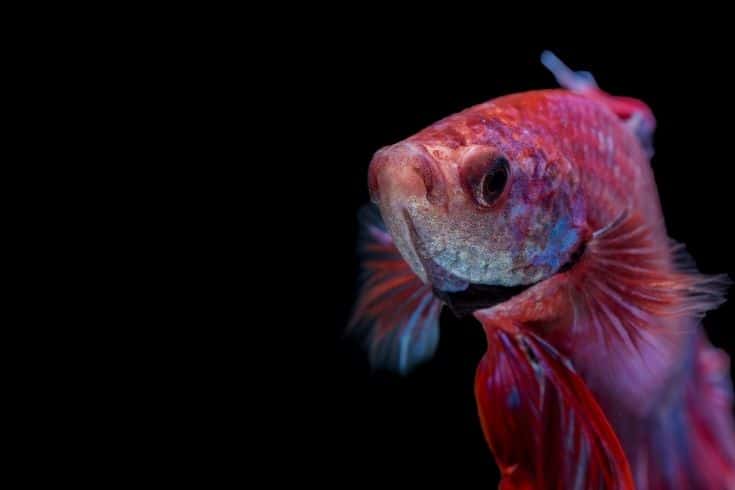
Now that we know 20 and 30-gallon tanks are large enough for bettas, let’s go over some of the factors that affect how many fish you can put into these tanks.
Fish Gender
The first factor is the gender of the fish. Both male and female betta fish are very territorial, but males tend to be much more aggressive than females. This means that you will likely be able to keep more female bettas in a 20 or 30-gallon tank than males, because you’ll be able to house female bettas together in a shared communal tank without them constantly fighting. These setups are commonly known as betta sorority tanks.
A 20-gallon sorority tank can house around 6 to 8 female bettas, while a 30-gallon tank can accommodate 10 to 12 fish. These stocking guidelines account for the fact that you’ll need to decorate your tank with plenty of hiding spots and plants to help reduce the aggression levels between the fish. Though they may be able to coexist, female bettas are not peaceful fish by any means, and you’ll still need to be prepared for the occasional tiff.
On the other hand, male bettas cannot be kept together in the same tank without fighting. Because of this, you’ll likely only be able to keep a single male betta in a 20 or 30-gallon tank. You could potentially keep more, but you’ll need to use dividers to section off the tank so each fish has its own little territory. We’ll cover this in more detail below.
Use Of Dividers
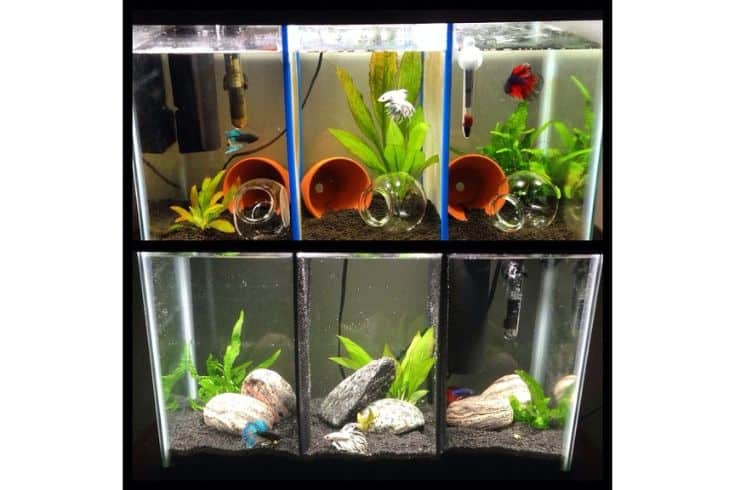
As we just mentioned, if you want to keep more than one male betta in a 20 or 30-gallon fish tank, you’ll need to use dividers to section off the tank. The dividers need to be opaque, so the fish cannot see each other, and they should extend all the way to the bottom of the tank to prevent the fish from swimming underneath. These setups are still technically communal tanks, but in practice, it is helpful to think about them as separate 5-gallon tanks housed within a larger 20 or 30-gallon shared aquarium.
The number of dividers you’ll need will depend on how many male bettas you want to keep in the tank. For example, a 20-gallon tank could theoretically accommodate 4 male bettas if you use 3 dividers to section off the tank, while a 30-gallon tank could hold 6 fish with 4 dividers. The minimum tank size for a single male betta is 5 gallons, so you’ll need to ensure each tank section is at least this large.
The use of dividers does present some challenges, though. First, you’ll need to ensure adequate filtration and aeration in each section of the tank because the dividers will block some of the water flow. The second challenge is that you’ll need to be very diligent about maintaining consistent water quality throughout the entire tank. However, if you’re up for the challenge, keeping multiple male bettas in a 20 or 30-gallon tank is definitely possible.
Frequency Of Tank Maintenance
Keeping your fish tank clean becomes more important the more fish you have, because there is more waste produced and ammonia can build up more quickly. A large tank containing many fish will require frequent water changes to maintain good water quality. For example, a 20-gallon tank with one betta fish should have a water change every 2 to 4 weeks, while a tank with 8 fish will need a water change every week.
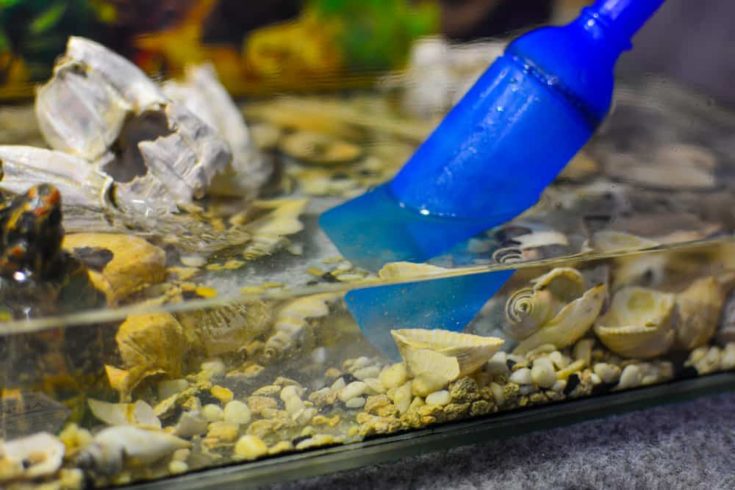
The stocking guidelines we’ve outlined above assume that you’re willing to do the necessary tank maintenance to keep your fish healthy. If you don’t want to be doing weekly water changes, it’s best to avoid caution and keep fewer fish in your tank. With time, getting used to your tank and observing your fish will help you determine the appropriate stocking level for your aquarium.
Beyond water changes, other tank maintenance aspects include ensuring that all the equipment is functioning properly and that the tank is free of algae and debris. For instance, a malfunctioning heater can subject your tropical fish to extremely hot temperatures that can be fatal, while a clogged filter can lead to poor water quality. Staying on top of these maintenance tasks is essential to keeping your fish healthy and happy.
Tank Decoration
Last but not least, we come to the topic of tank decoration. The size of your fish tank will obviously dictate how many and what types of decorations you can have, but did you know that the reverse is also true? Think about it – a 20-gallon aquarium with plenty of plants, though beautiful, will provide far less swimming space for your fish than a bare-bones tank of the same size. So, your tank decor will also influence how many fish you can keep.
Of course, there’s no right or wrong answer when it comes to tank decoration. It ultimately comes down to personal preference. However, we would recommend avoiding decorations that could potentially harm your fish, such as artificial plants with sharp edges or natural plants that may be poisonous. In general, it’s best to stick with safe, soft plants to help provide your fish with hiding places and oxygenate the water.
Keeping all of this in mind, let’s take a closer look at how many bettas you can keep in a 20 and 30-gallon tank.
How Many Bettas Can You Keep In A 20 and 30 Gallon Tank?
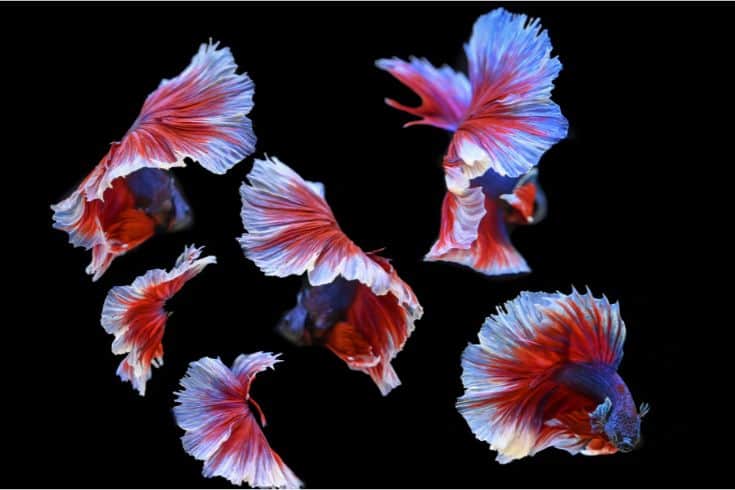
So, how many bettas can you keep in a 20 and 30-gallon tank? The answer, as we’ve explained, depends on a number of factors, but here are some general guidelines:
Number of Female Fish
If you’re establishing a betta sorority tank, you can typically keep 4-6 females per 20 gallons, and 6-8 females per 30 gallons. Remember to provide plenty of hiding places and plants for the fish to feel comfortable and safe. Squabbles are bound to happen from time to time, so providing caves and plants for the fish to retreat to is essential.
Remember not to dip below 4 females per 20 gallons, as this can create a power imbalance between dominant and submissive fish, leading to bullying and stress. There is comfort and safety in numbers because it prevents any fish from feeling isolated or singled out.
Number of Male Fish
Male bettas can be kept singly, in groups of 4-5 males per 20 gallons, or in groups of 6-8 males per 30 gallons. Dividers are an absolute must if you’re keeping more than one male. Males will often fight to the death if they’re not separated, all in the name of claiming their territory. As a responsible betta owner, it’s your job to provide a safe and stress-free environment for your fish, which means keeping them properly separated.
Of course, you can also opt to house one male betta in a 20 or 30-gallon tank. If you have the space and you’re willing to do the necessary maintenance, a single male betta can thrive in a larger tank. Just be sure to provide plenty of hiding places and plants for the fish to feel comfortable. Too much space can cause your fish to feel exposed and vulnerable, so creating tiny crevices and hiding spots is key.
Fish Fry
A 20 or 30-gallon breeder tank is fairly common for fish fry as it is a good size for a group with plenty of space to grow. Betta fry in particular need warmth and security, so a smaller tank is often best. However, if you’re fry-savvy and you have the space, a 20 or 30-gallon tank can easily accommodate up to 60 fry. Just remember to keep a close eye on the fry and be prepared to do regular water changes to maintain water quality.
Another thing to note is that fry need to be separated from one another as they grow. This is because, as they mature, the fry will start to develop their own territory and become aggressive towards one another. Establishing a fry-rearing tank with plenty of dividers is essential to keeping your fry safe and healthy.
Common Mistakes
Having covered all of the basics, we want to take a moment to address some common mistakes that betta owners make when setting up their tanks.
Placing A Male and Female Fish Together
One of the most common mistakes that betta owners make is placing a male and female fish together. On paper, it seems like a good idea – after all, what’s cuter than a pair of love-struck bettas? Unfortunately, in reality, it’s a recipe for disaster. Male fish tend to be aggressive towards females, often nipping at their fins or chasing them around the tank. This can cause the female fish a great deal of stress, leading to illness and, in some cases, death.
Therefore, it’s best to avoid placing a male and female fish together unless you’re planning to breed them. If you decide to breed your bettas, be sure to separate the male and female fish soon after fertilization.
Not Providing Enough Hiding Places
As we’ve mentioned, bettas are very shy fish and they need plenty of hiding places to feel comfortable. A common mistake betta owners make is not providing enough places to hide their fish. This can cause the fish a great deal of stress, leading to illness and poor quality of life. Since bettas are extremely susceptible to various illnesses, it’s important to do everything you can to reduce their stress levels.
Therefore, when setting up your tank, include plenty of plants, rocks, and other hiding places. This is especially important if you have more than one fish in the tank. Short of placing each fish in a separate tank, there’s no way to eliminate territorial disputes. However, providing plenty of hiding places can help reduce the amount of fighting, thus leading to a happier and healthier environment for your fish.
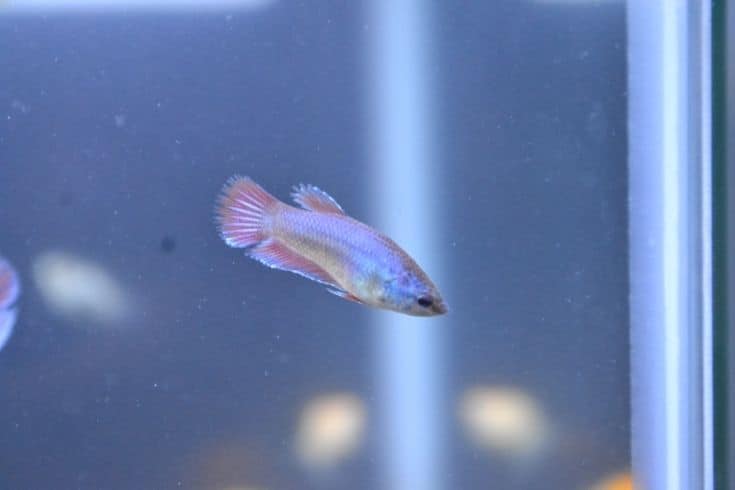
Overstocking the Tank
Another common mistake that betta owners make is overstocking their tanks. This is often done out of a desire to have a ” fuller” looking tank, but it’s actually very detrimental to the health of your fish. An overstocked tank can cause ammonia and nitrite levels to skyrocket, leading to serious illness and even death. In addition, overstocked tanks are much more difficult to clean and maintain, making it more likely that your fish will become sick.
Therefore, it’s important to avoid overstocking your betta tank. A good rule of thumb is to allocate between 3-5 gallons of water per betta. This will give your fish plenty of room to swim and reduce the likelihood of water quality problems.
The Bottom Line
We hope this article has helped you better understand how many bettas can be safely housed in a 20 or 30-gallon tank. Remember, when it comes to bettas, quality is always better than quantity. A single fish in a well-maintained tank will be much happier and healthier than a dozen fish crammed into a small bowl.
If you have any questions about betta care, or if you’re looking for advice on setting up your tank, be sure to check out our other articles or contact us directly. We’re always happy to help!
